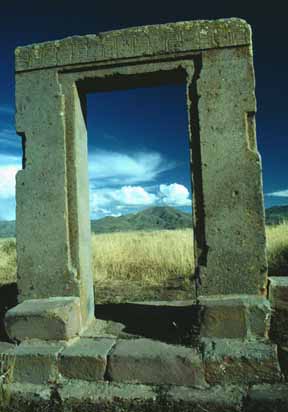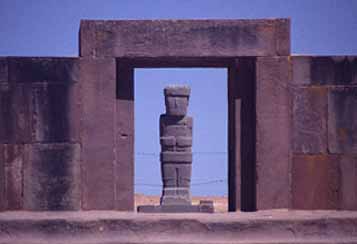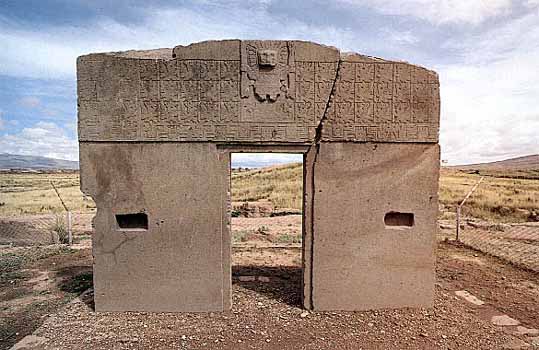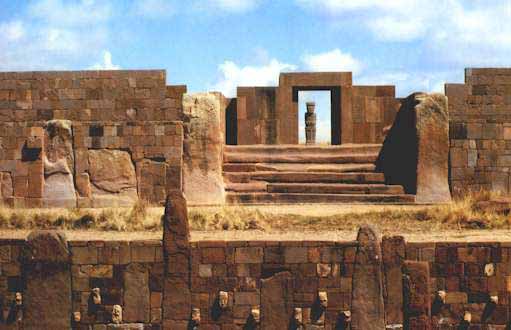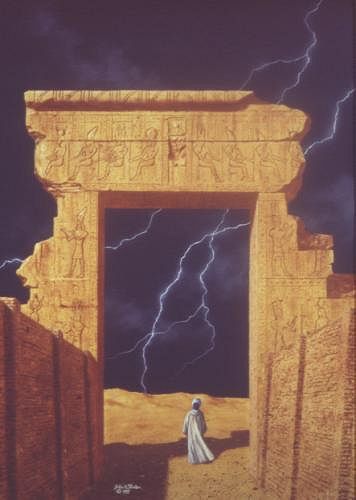|
The Gateways to the Gods In this section we
will cover various sites around the world that
have been described as gateways to the Gods by the
local legends. These are temporary posts and will
get a page of there own once enough data is
available. Entries here will be short posts as we
find them. It will include Sci Fi examples and Art
work examples |
||||
|
. Screen Capture by Holger Stoehr © Info |
||||
|
Aramu Maru, Peru Gateway to the Lands of the Gods .
September 1996 - by Paul Damon A huge mysterious door like structure has recently been discovered in the Hayu Marca mountain region of Southern Peru. Hayu Marca, 35 kilometers from the city of Puno has long been revered by local indians as the "City of the Gods", and has never been fully explored because of the rugged mountain terrain. Although no actual city has ever been discovered, many of the rock formations of the region resemble buildings and artificial structures. The door, or the "Puerta de Hayu Marca" (Gate of the gods/spirits) has been at some time in the distant past carved out of a natural rock face and in all measures exactly seven meters in height by seven meters in width with a smaller alcove in the center at the base, which measures in at just under two meters in height. Jose Luis Delgado Mamani stumbled across the structure while trekking through the surrounding foothills trying to familiarize himself with the area as his job is as a guide for mountaineering tourists. |
||||
|
Tiahuanaco, Bolivia
The Sun Gate now stands in the northwest corner of the Kalasasaya temple..
|
||||
A pair of Lamassu figures flanking the gateway act as guardians. See Dur Sharrukin |
||||
|
.
The Ishtar Gate was built and dedicated to the goddess Ishtar around 575 BC. It was awesome in appearance and one of the most impressive monuments of the ancient Near East. It was decorated with glazed brick relief, in tiers, of dragons and young bulls. The gate was a double gate, and it was the starting point for the half mile Processional Way to the Temple of Marduk. This gate was built by Nebuchadnezzar II, the same monarch who conquered Jerusalem in 586 BC. The Ishtar Gate foundations were discovered in 1899, and were reconstructed in the Pergamon Museum, Berlin, from the glazed bricks and other material excavated by the Robert Koldeway expedition in the early 1900's. This discovery was monumental in the study of Biblical Archaeology, the very Gate which the Jewish captives must have passed through, including Daniel and Ezekiel. It shows the might and glory of the Babylonian Empire. "Is not this the great Babylon I have built as the royal residence, by my mighty power and for the glory of my majesty?" The words were still on his lips when a voice came from heaven, "This is what is decreed for you, King Nebuchadnezzar: Your royal authority has been taken from you." Daniel 4:30-31 The Ishtar Gate at Babylon - Reconstruction
Glazed Brick The Ishtar Gate, one of the eight gates of the inner city of Babylon, was built during the reign of Nebuchadnezzar II (604- 562 BC). Only the foundations of the gate were found, going down some 45 feet, with molded, unglazed figures. The gateway has been reconstructed in the Pergamon Museum, Berlin, from the glazed bricks found, so its original height is different in size. Reconstructed height is 47 feet. It was one of the eight gates of the inner city of Babylon. It was built in about 575 BC, the eighth fortified gate in the city. It is one of the most impressive monuments rediscovered in the ancient Near East. The Ishtar gate was decorated with glazed brick relief, in tiers, of dragons and young bulls. The gate itself was a double one, and on its south side was a vast antechamber. Through the gatehouse ran a stone and brick paved avenue, the so-called Processional Way, which has been traced over a length of more than half a mile. King Nebuchadnezzar II of Babylon dedicated the great Ishtar Gate to the goddess Ishtar. It was the main entrance into Babylon. King Nebuchadnezzar II performed elaborate building projects in Babylon around 604-562 BC. His goal was to beautify his capital. He restored the temple of Marduk, the chief god, and also built himself a magnificent palace with the famous Hanging Gardens, which was reported by the Greek historian Herodotus to have been one of the wonders of the world. The Bible records that it was Nebuchadnezzar who destroyed Jerusalem, brought the kingdom of Judah to an end, and carried off the Jews into exile. The Ishtar Gate was the starting point for processions. The Babylonians would assemble in front of it and march through the triumphal arch and proceed along the Sacred Way to the 7 story Ziggurat, which was crowned near the temple of Marduk. The gateway was completely covered with beautifully colored glazed bricks. Its relief of dragons and bulls symbolized the gods Marduk and Adad. Enameled tiles of glorious blue surrounded the brightly colored yellow and brown beasts. In front of the gateway outside the city was a road with walls decorated with relief of lions and glazed yellow tiles. The Ishtar gate was reconstructed in Berlin out of material excavated by Robert Koldeway. The Dedicatory Inscription on the Ishtar Gate reads: "Nebuchadnezzar, King of Babylon, the faithful prince appointed by the will of Marduk, the highest of princely princes, beloved of Nabu, of prudent counsel, who has learned to embrace wisdom, who fathomed their divine being and reveres their majesty, the untiring governor, who always takes to heart the care of the cult of Esagila and Ezida and is constantly concerned with the well being of Babylon and Borsippa, the wise, the humble, the caretaker of Esagila and Ezida, the firstborn son of Nabopolassar, the King of Babylon. Both gate entrances of Imgur-Ellil and Nemetti-Ellil following the filling of the street from Babylon had become increasingly lower. Therefore, I pulled down these gates and laid their foundations at the water table with asphalt and bricks and had them made of bricks with blue stone on which wonderful bulls and dragons were depicted. I covered their roofs by laying majestic cedars length-wise over them. I hung doors of cedar adorned with bronze at all the gate openings. I placed wild bulls and ferocious dragons in the gateways and thus adorned them with luxurious splendor so that people might gaze on them in wonder. I let the temple of Esiskursiskur (the highest festival house of Markduk, the Lord of the Gods a place of joy and celebration for the major and minor gods) be built firm like a mountain in the precinct of Babylon of asphalt and fired bricks." SOURCE
-
Bible History Online |
||||
|
"Gateway to the Gods" Thor's Gate
at Columcille
©2006-2007 ~TearsOfTheFallen
Columcille
Megalith Park
2155 Fox Gap Rd Bangor, Pennsylvania 18013 http://www.columcille.org/ Not sure if this has been restored or is still abandoned. Man made spiritual retreat |
||||
|
||||
| FAIR USE NOTICE: This page contains copyrighted material the use of which has not been specifically authorized by the copyright owner. Pegasus Research Consortium distributes this material without profit to those who have expressed a prior interest in receiving the included information for research and educational purposes. We believe this constitutes a fair use of any such copyrighted material as provided for in 17 U.S.C § 107. If you wish to use copyrighted material from this site for purposes of your own that go beyond fair use, you must obtain permission from the copyright owner. | ||||
| ~ MENU ~ |

